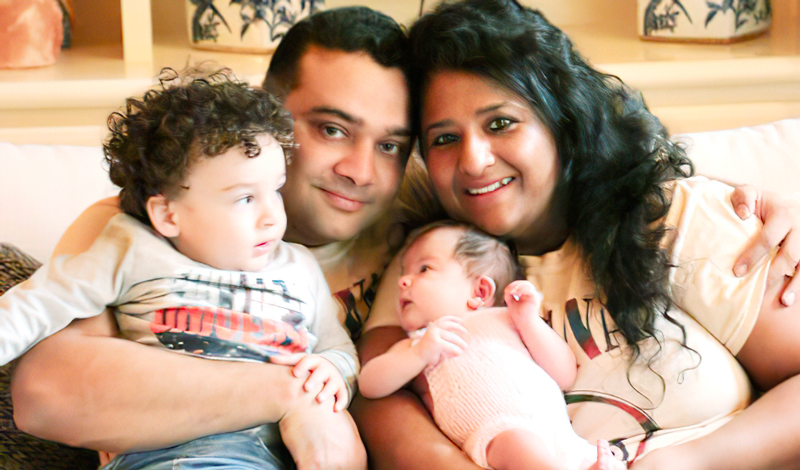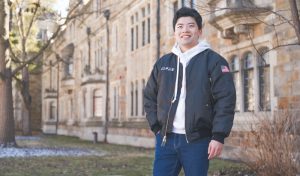by Ajay Marar
Seattle
On Sept. 21, my wife, Shefali, and I, were visited in the night by our greatest fear. Thirty-six weeks pregnant with our second child, Shefali woke in a pool of blood. Early on, the placenta’s abnormal location posed a threat to both her life and the baby’s. But until that night, the condition had remained benign. In the ambulance on our way to the hospital, her hand in mine, we chanted Nam-myoho-renge-kyo.
Ikeda Sensei has said that a person’s true nature is revealed at times of the greatest adversity. Indeed, adversity marked our relationship from the outset, and Shefali revealed herself as a person of courage. In the eyes of many doctors, her near decade-long battle with cancer, alongside other long-standing health challenges, left us with virtually no hope of having children. But we held fast to our dream in one hand and the great sword of the Lotus Sutra in the other. In 2011, the year of the cancer diagnosis, we bought a small T-shirt for our child-to-be, printed with a baby elephant and its parents.
In the nine years that followed, we failed repeatedly to conceive, exhausting every treatment. We never gave up hope, and when we finally became pregnant, in early 2019, we were ecstatic. But our joy was short-lived: We soon miscarried. Shattered, we continued to chant. In time, we determined that our child had carried out a profound mission, connecting us more deeply to the Gohonzon and awakening us to our unlimited potential. After eight years of struggle, eight years’ worth of doctors warning us against hope, we had proven our hope had been worth having.
Our victory was meant to shine as irrefutable proof of the power of this practice, inspiring many people to embark on the journey of their human revolution. As we chanted, we summoned up deep gratitude for our brief encounter with our baby. Our prayer gave rise to fresh conviction and a vow to achieve the impossible. Within months, Shefali was pregnant again.
The first six months were uneventful. Then, a routine ultrasound took us to Seattle Children’s Hospital, where we were told our baby had a potentially serious heart valve disorder.
“Another setback, another opportunity,” Shefali told me. We chanted like lions, attending SGI meetings and encouraging others to practice. Shefali did what she does best: shrug off bleak news. She paused during evening gongyo and turned to me. Quietly, but with great intensity, she said, “My child is coming into the world as a kosen-rufu baby and I know he will come unscathed.” A month later, the doctors told us our baby had a perfectly functioning heart.
Arjun arrived five weeks early, at the tail end of 2019. It was as though he wanted to remind us that “winter always turns to spring” (“Winter Always Turns to Spring,” The Writings of Nichiren Daishonin, vol. 1, p. 536). He also reminded us that life is about scaling one mountain after another. Arjun came with severe respiratory distress. Intubated at the neonatal intensive care unit, he was also diagnosed with a life-threatening disease. The readings indicated the presence of the illness 10 times above average. I asked the doctor if it could be a false positive. He told me he had never seen a reading that high turn out to be a false positive. Still, secondary testing was necessary to confirm the diagnosis.
That very day, I reached out to my region men’s leader and told him I wanted to share a winning experience about my son. I wrote out this experience immediately. Three weeks later, doctors informed us that Arjun was completely in the clear. Signs of the disease had vanished. At Seattle’s February 2020 Kosen-rufu Gongyo Meeting, I shared the experience. In closing, I read: “I am a Bodhisattva of the Earth! I will be victorious over and over again! I will defeat all obstacles and challenges that lie ahead of me!”

Earlier this year, our entire family tested positive for COVID-19. While Arjun and I recovered within a week, Shefali’s symptoms persisted for nearly a month. We consulted a doctor who broke the happy news that the symptoms were due not to COVID-19 but from another pregnancy. For 10 years, we had struggled to conceive a single child. Now, within just two years, we were having another.
Happy news followed by 36 weeks of smooth sailing. And then this episode in the night, Shefali waking in blood, chanting daimoku in the ambulance. The doctors performed an emergency cesarean section to bring our daughter, Nirvana, into the world.
Unsurprisingly, she was born with the very respiratory distress as had been her brother. The message was clear to me: I needed to wield again the sword of the Lotus Sutra to banish this karma from my daughter’s life.
I once again resolved to share a winning experience. As with Arjun, I was confident that we would emerge victorious. On Oct. 3, the SGI center in Seattle opened, and I shared our victory at the first in-person kosen-rufu gongyo meeting there. Just before I spoke, we learned that Nirvana would be discharged from the hospital that day.
The life I led 10 years ago, before Shefali introduced me to the practice, was defined by predictable, unremarkable events. Had doctors told the man I was “I’m sorry, a family won’t be possible for you and your wife. This is the end of the road…” that would have indeed been the end of the road. Since then, however, we have wielded the sword of the Lotus Sutra to slice through every impasse standing between us and our dreams. The joy and the struggle now are to share this Nam-myoho-renge-kyo with others so they can do the same.
from Nichiren Daishonin (“On Establishing the Correct Teaching,” The Writings of Nichiren Daishonin, vol. 1, p. 17)
A blue fly, if it clings to the tail of a thoroughbred horse, can travel ten thousand miles, and the green ivy that twines around the tall pine can grow to a thousand feet.
You are reading {{ meterCount }} of {{ meterMax }} free premium articles





